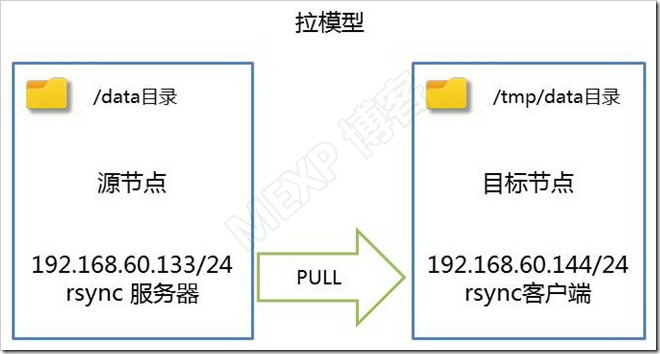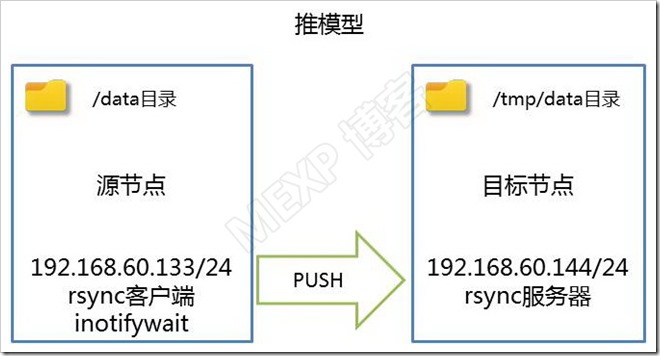一、前言
无论使用什么操作系统下,都经常有同步文件的需求,不管发生在本地,还是发生在本地和远程主机之间。那么应该怎么做呢?
使用拷贝类的命令,本地使用cp命令,复制到远程主机使用scp这样的命令,保证复制到目标和源的一模一样。
但是,这种复制一般来说,只能判断文件在目标中是否存在,然后对存在的文件或目录可以选择覆盖或者不复制,覆盖能保证文件一致,不复制就不能保证一致,不存在的则创建这个文件或者目录。
每次同步如果都采用覆盖,即使只是少数文件发生部分变化,也是全部文件都覆盖,源和目标倒是保证一致了。但这种方式,会造成极大的网络带宽压力和源、目标磁盘IO的压力。
如果源中有1G数据怎么办,或者更多数据怎么办?
Linux下提供了一款工具rsync,它能够实现本地之间或者本地和远程之间的数据同步,它能通过分块滚动校验和算法和hash算法来计算文件的差异,源端负责计算出差异,将匹配块引用和差异序列发回目标端,由目标端重新组织生成新的文件。
它的特征是:
-
分块提取特征码,比较差异
-
对有差异的文件,进行增量复制
这样大大的节省了带宽和IO。
二、rsync的推拉模型
(一)服务模式
rsync的使用模型中,生成环境用的最多的还是跨主机间同步,也就是要使用服务模式。
rsync的服务模式
Pull: rsync [OPTION...] [USER@]HOST::SRC... [DEST]
rsync [OPTION...] rsync://[USER@]HOST[:PORT]/SRC... [DEST]
Push: rsync [OPTION...] SRC... [USER@]HOST::DEST
rsync [OPTION...] SRC... rsync://[USER@]HOST[:PORT]/DEST
| -v, --verbose | 详细信息输出 |
| -q, --quiet | 不显示非错误信息 |
| -a, --archive | 归档模式 |
| -r, --recursive | 递归目录 |
| -z, --compress | 启用数据压缩 |
| --delete | 删除目标目录中多余的文件 |
| --progress | 显示进度 |
| --password-file=FILE | 密码文件存放路径,注意这个文件的权限 |
(二)拉模型
拉模型指的是主动去服务器的指定端口获取数据

通过rsync服务拉模型同步:
目标节点主动的连接到源节点后,双方比较文件差异,然后从源节点同步文件差异生成新文件以求保持一致。
目标节点需要定时去访问源节点,时间间隔不宜过于快,也不宜过慢。
而且比较差异,是遍历整个目录文件,是非常占资源的事情。
从以上分析可以看出,目标节点主动拉取数据是基于查询机制的,非常没有效率。
那么,解决问题的办法是使用一种机制,能够获取到源节点数据的变化之后,再启动同步,这将大大减少资源的占用。而Linux给我们提供了这种机制,就是inotify。
inotify: Linux从2.6.13内核开始引入。通过inotify可以监控文件系统的添加、删除、修改、移动等各种细微事件,利用这个内核接口,第三方软件可以监控文件系统的各种变化,而inotify-tools就是其中一种工具。
(三)推模型
推模型指的是将数据主动推送至服务器指定端口

推模型一样存在怎样推送、间隔多久推送的问题!
但是,推模型可以结合inotify来决定什么时候推送数据。
让源节点通过inotify探查到同步目录中文件发生了改变,然后源节点主动的将文件推至目标节点,这将大大提高效率。
这样,源节点使用inotify + rsync客户端,目标节点配置rsync的服务器。
下面就依照推模型的规划来完成本次实验。
三、inotify + rsync的推模型方案实验
本次实验使用的操作系统是CentOS 6.5。
# uname -r
2.6.32-431.el6.x86_64
其确保内核的版本是2.6.13之上。
(一)目标节点配置
1、准备服务程序
rsync需要依赖超级守护进程xinetd,服务默认监听在TCP的873端口,客户端连接此端口,来推送数据或者拉取数据。
# yum -y install xinetd # yum -y install rsync [root@localhost ~]# sed -i 's/yes/no/' /etc/xinetd.d/rsync [root@localhost ~]# cat /etc/xinetd.d/rsync # default: off # description: The rsync server is a good addition to an ftp server, as it \ # allows crc checksumming etc. service rsync
{ disable = no
flags = IPv6
socket_type = stream
wait = no
user = root
server = /usr/bin/rsync
server_args = --daemon
log_on_failure += USERID
}
# mkdir /tmp/data/ –v
2、提供配置文件
# vim /etc/rsyncd.conf uid = nobody
gid = nobody
use chroot = no
max connections = 10
pid file = /var/run/rsyncd.pid
log file = /var/log/rsyncd.log
[data]
path = /tmp/data
ignore errors = yes
read only = true
write only = no
list = true
host allow = 192.168.60.0/24
host deny = *
uid = root
gid = root
auth users = tiger, tom
secrets file = /etc/rsyncd.secrets
3、准备用户认证文件
# vim /etc/rsyncd.secrets tiger:tigeradm
tom:tomadm
# chmod 600 /etc/rsyncd.secrets
说明
write only如果是yes(true)就不许下载,也就是说,如果是no(false)就允许下载,但要检查是否有权限。
auth users 用户认证
secrets file 指明用户认证所使用的用户名和密码所存储的文件。注意这个文件的权限要400或者600。
4、启动服务
启动超级守护进程,让它代为监听TCP 873端口。
# service xinetd start Starting xinetd: [ OK ]
# ss -tnlp | grep :873 LISTEN 0 64 :::873 :::* users:(("xinetd",1443,5))
(二)源节点配置
1、安装rsync
# yum -y install rsync # mkdir /data/ # rsync -vv rsync://tom@192.168.60.144/data/* /data/ opening tcp connection to 192.168.60.144 port 873
sending daemon args: --server --sender -vve.Ls . "data/*" Password:
delta-transmission enabled
a.txt
test.txt
sent 91 bytes received 189 bytes 20.74 bytes/sec
total size is 0 speedup is 0.00
2、安装inotify-tools
# tar xf inotify-tools-3.13.tar.gz # cd inotify-tools-3.13 # ./configure # make # make install
3、inotifywait
inotify-tools提供了有用的工具inotifywait。
| -r | 监视目录及其子目录 |
| -m | 始终处于事件监听状态不退出 |
| -q --quiet | 静默,只打印时间 |
| -e --event | 指定监听的事件,如果不指定,监听所有事件 |
| --exclude | 使用扩展正则表达式描述的排除文件 |
| --excludei | 使用扩展正则表达式描述的排除文件,忽略大小写 |
| --format | 指定打印的格式,类似printf。 %w 发生事件的目录名称 %f 发生事件的文件名称 %e 发生的事件 %Xe 使用X分隔发生的事件 %T --timefmt选项指定的时间格式 |
| --timefmt | 使用和strftime兼容的格式的时间格式 |
| access | 文件或目录内容被读取 |
| modify | 文件或目录内容被写入 |
| attrib | 文件或目录属性改变,即元数据被修改 |
| close_write | 在可写模式打开后关闭 |
| close_nowrite | 在只读模式打开后关闭 |
| close | 不管是否读写模式,只要是关闭 |
| open | 打开 |
| moved_to | 文件或目录移动至监控目录 |
| moved_from | 文件或目录从监控目录移动走 |
| move | 只要监控目录有移动事件 |
| create | 在监控目录有文件或目录被创建 |
| delete | 在监控目录有文件或目录被删除 |
| delete_self | 监控的目录和文件本身被删除 |
| unmount | 包含文件或目录的文件系统卸载 |
[ 事件分析 ]
使用下面的命令,来分析一下各种操作产生的事件是什么,从而分析出哪些事件是需要监控的。
# inotifywait -rm --format "%T %w %f %e" --timefmt "%Y-%m-%d %H:%M:%S" --excludei ".*\.(swp|swx|swpx)$" /data/
[root@localhost /]# cd /data/
无事件
[root@localhost data]# ls
2014-08-31 06:32:55 /data/ OPEN,ISDIR
2014-08-31 06:32:55 /data/ CLOSE_NOWRITE,CLOSE,ISDIR
事件:open close_nowrite close
[root@localhost data]# touch test
2014-08-31 06:35:54 /data/ test CREATE
2014-08-31 06:35:54 /data/ test OPEN
2014-08-31 06:35:54 /data/ test ATTRIB
2014-08-31 06:35:54 /data/ test CLOSE_WRITE,CLOSE
事件:create open attirb close_write close
[root@localhost data]# mkdir content
2014-08-31 06:36:58 /data/ content CREATE,ISDIR
2014-08-31 06:36:58 /data/ content OPEN,ISDIR
2014-08-31 06:36:58 /data/ content CLOSE_NOWRITE,CLOSE,ISDIR
事件:create open close_nowrite close
[root@localhost data]# ls content/
2014-08-31 06:40:10 /data/ content OPEN,ISDIR
2014-08-31 06:40:10 /data/content/ OPEN,ISDIR
2014-08-31 06:40:10 /data/ content CLOSE_NOWRITE,CLOSE,ISDIR
2014-08-31 06:40:10 /data/content/ CLOSE_NOWRITE,CLOSE,ISDIR
事件:open close_nowrite close
[root@localhost data]# cp /etc/issue content/
2014-08-31 06:41:23 /data/ OPEN,ISDIR
2014-08-31 06:41:23 /data/ CLOSE_NOWRITE,CLOSE,ISDIR
2014-08-31 06:41:25 /data/content/ issue CREATE
2014-08-31 06:41:25 /data/content/ issue OPEN
2014-08-31 06:41:25 /data/content/ issue MODIFY
2014-08-31 06:41:25 /data/content/ issue CLOSE_WRITE,CLOSE
事件:open close_nowrite close create open modify
[root@localhost data]# cat content/issue
2014-08-31 06:44:09 /data/content/ issue OPEN
2014-08-31 06:44:09 /data/content/ issue ACCESS
2014-08-31 06:44:09 /data/content/ issue CLOSE_NOWRITE,CLOSE
事件:open access close_nowrite close
[root@localhost data]# nano testfile
2014-08-31 07:50:35 /data/ testfile CREATE
2014-08-31 07:50:35 /data/ testfile OPEN
2014-08-31 07:50:35 /data/ testfile MODIFY
2014-08-31 07:50:35 /data/ testfile CLOSE_WRITE,CLOSE
事件:create open modify close_write close
[root@localhost data]# vim content/issue
2014-08-31 06:51:03 /data/ OPEN,ISDIR
2014-08-31 06:51:03 /data/ CLOSE_NOWRITE,CLOSE,ISDIR
2014-08-31 06:51:03 /data/ OPEN,ISDIR
……
2014-08-31 06:51:03 /data/content/ issue OPEN
2014-08-31 06:51:03 /data/content/ .issue.swpx CREATE
2014-08-31 06:51:03 /data/content/ .issue.swpx OPEN
2014-08-31 06:51:03 /data/content/ .issue.swpx CLOSE_WRITE,CLOSE
2014-08-31 06:51:03 /data/content/ .issue.swpx DELETE
2014-08-31 06:51:03 /data/ OPEN,ISDIR
2014-08-31 06:51:03 /data/ CLOSE_NOWRITE,CLOSE,ISDIR
2014-08-31 06:51:03 /data/ OPEN,ISDIR
2014-08-31 06:51:03 /data/ CLOSE_NOWRITE,CLOSE,ISDIR
2014-08-31 06:51:03 /data/content/ issue CLOSE_NOWRITE,CLOSE
2014-08-31 06:51:03 /data/content/ issue OPEN
2014-08-31 06:51:03 /data/content/ issue ACCESS
2014-08-31 06:51:03 /data/content/ issue CLOSE_NOWRITE,CLOSE
2014-08-31 06:51:03 /data/ OPEN,ISDIR
2014-08-31 06:51:03 /data/ CLOSE_NOWRITE,CLOSE,ISDIR
2014-08-31 06:51:12 /data/ OPEN,ISDIR
2014-08-31 06:51:12 /data/ CLOSE_NOWRITE,CLOSE,ISDIR
2014-08-31 06:51:12 /data/content/ 4913 CREATE
2014-08-31 06:51:12 /data/content/ 4913 OPEN
2014-08-31 06:51:12 /data/content/ 4913 ATTRIB
2014-08-31 06:51:12 /data/content/ 4913 CLOSE_WRITE,CLOSE
2014-08-31 06:51:12 /data/content/ 4913 DELETE
2014-08-31 06:51:12 /data/content/ issue MOVED_FROM
2014-08-31 06:51:12 /data/content/ issue~ MOVED_TO
2014-08-31 06:51:12 /data/content/ issue CREATE
2014-08-31 06:51:12 /data/content/ issue OPEN
2014-08-31 06:51:12 /data/content/ issue MODIFY
2014-08-31 06:51:12 /data/content/ issue CLOSE_WRITE,CLOSE
2014-08-31 06:51:12 /data/content/ issue ATTRIB
2014-08-31 06:51:12 /data/content/ issue ATTRIB
2014-08-31 06:51:12 /data/content/ issue~ DELETE
2014-08-31 06:51:12 /data/ OPEN,ISDIR
2014-08-31 06:51:12 /data/ CLOSE_NOWRITE,CLOSE,ISDIR
事件:create open attrib delete modify moved_from moved_to close_write close
下面是使用vim打开,无修改关闭的日志
2014-08-31 06:46:51 /data/content/ issue CLOSE_NOWRITE,CLOSE
2014-08-31 06:46:51 /data/content/ issue OPEN
2014-08-31 06:46:51 /data/content/ issue ACCESS
2014-08-31 06:46:51 /data/content/ issue CLOSE_NOWRITE,CLOSE
可以看出关键的事件是close_nowrite
[root@localhost data]# mv content/issue /tmp/
2014-08-31 06:52:48 /data/content/ issue MOVED_FROM
[root@localhost data]# mv /tmp/issue /data/content/
2014-08-31 06:54:55 /data/content/ issue MOVED_TO
事件:moved_from moved_to
[root@localhost data]# rm /data/content/issue
2014-08-31 06:58:25 /data/content/ issue DELETE
[root@localhost data]# rm -rf /data/content
2014-08-31 06:59:53 /data/ content OPEN,ISDIR
2014-08-31 06:59:53 /data/content/ OPEN,ISDIR
2014-08-31 06:59:53 /data/content/ t1.txt DELETE
2014-08-31 06:59:53 /data/ content DELETE,ISDIR
2014-08-31 06:59:53 /data/ content CLOSE_NOWRITE,CLOSE,ISDIR
2014-08-31 06:59:53 /data/content/ CLOSE_NOWRITE,CLOSE,ISDIR
2014-08-31 06:59:53 /data/content/ DELETE_SELF
2014-08-31 06:59:53 /data/content/ IGNORED
事件:open delete delete_self close_nowrite close
[root@localhost data]# chmod 400 testfile
2014-08-31 08:22:53 /data/ testfile ATTRIB
事件:attrib
由此可见,一个监控中的文件夹内容改变的主要事件有:create delete attrib close_write。
选取create是因为,目录的创建,不会发生close_write事件。
文件的创建,create事件产生,保存退出,会产生close_write事件。文件的修改,modify事件产生,保存退出,会产生close_write事件。所以选取close_write。
修改一个文件属性,只会产生attrib事件,所以要选取它。
文件或目录的删除都会产生delete事件。
4、部署inotify监控
创建访问目标节点的访问密码文件
# echo "tomadm" > /etc/rsync.accesspasswd # cat /etc/rsync.accesspasswd tomadm
# chmod 400 /etc/rsync.accesspasswd
5、推送测试
# rsync -avzr --delete --progress --password-file=/etc/rsync.accesspasswd /data/* rsync://tom@192.168.60.144/data/ sending incremental file list
ERROR: module is read only
rsync error: syntax or usage error (code 1) at main.c(866) [receiver=3.0.6]
rsync: read error: Connection reset by peer (104)
rsync error: error in rsync protocol data stream (code 12) at io.c(759) [sender=3.0.6] 修改目标节点的配置文件,修改为可写,但不可下载。然后再次测试
# sed -i -e 's/read only.*/read only = no/' -e 's/write only.*/write only = yes/' /etc/rsyncd.conf # rsync -avzr --delete --progress --password-file=/etc/rsync.accesspasswd /data/* rsync://tom@192.168.60.144/data/ sending incremental file list
apx.txt
0 100% 0.00kB/s 0:00:00 (xfer#1, to-check=3/5) issue
68 100% 0.00kB/s 0:00:00 (xfer#2, to-check=2/5) test.txt
0 100% 0.00kB/s 0:00:00 (xfer#3, to-check=1/5) ttt/
sent 283 bytes received 69 bytes 33.52 bytes/sec
total size is 68 speedup is 0.19
6、提供后台运行脚本
提供脚本/usr/local/scripts/inotesync.sh,内容如下
#!/bin/bash prog=inotesync
dir=/data/
user=tom
romote=192.168.60.144
logfile=/var/log/${prog}.log { /usr/local/bin/inotifywait -rmq -e create,attrib,delete,close_write --format "%T %e %w%f" --timefmt "%Y-%m-%d %H:%M:%S" $dir | while read line
do
/usr/bin/rsync -avzr --delete --progress --password-file=/etc/rsync.accesspasswd $dir rsync://$user@$romote$dir
done
} >> $logfile &
# chmod +x /usr/local/scripts/inotesync.sh # echo "/usr/local/scripts/inotesync.sh" >> /etc/rc.local 重启测试成功。
脚本说明:
1、在rc.local尾部追加脚本路径,使其启动时运行
2、inotifywait、rsync使用绝对路径,否则脚本将不能正常运行,因为此时环境变量PATH还没有起作用
3、为了排错或者查看信息,使用一个花括号将语句块套起来,这样语句块内的所有的日志输出重定向到日志文件中
4、使用&符号,让命令后台执行
至此,使用inotify+rsync的推模型实验完成。
四、总结
inotify+rsync的推模型,很好的解决了拉模型中的几个问题,做到了有变化再做同步。但是使用inotify来监控文件夹,只是在监控的事件发生的时候,触发了一个事件,而每触发一个事件,rsync都要遍历比较所有文件和目录。当目录中文件非常多的时候效率也不高。
可以考虑从inotifywait的输出信息中,提取被创建、改变的文件,推送到目标节点。
参考资料
http://en.wikipedia.org/wiki/Rsync
http://zh.wikipedia.org/zh/Inotify
http://tutorials.jenkov.com/rsync/index.html
http://rsync.samba.org/tech_report/tech_report.html
http://en.wikipedia.org/wiki/Rolling_hash
http://blog.csdn.net/liuaigui/article/details/5793706
http://www.ibm.com/developerworks/cn/linux/l-inotify/
http://www.cnblogs.com/jingzhishen/p/3738637.html
转载于:https://blog.51cto.com/me2xp/1549624




)



-Non-Overlapping Context)




 (下))


)


